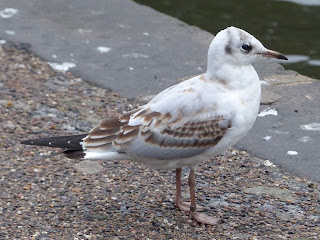It was about 20 degrees on Thursday, so I popped down to Linacre in the afternoon for 3 hours to see what was about. In the sun there were lots of butterflies in and around the buddleia in the ringing site, including:
Painted Lady (8 - it's been a fantastic year nationwide for this species, and my best ever at Linacre too),
Red Admiral (1),
Peacock (2),
Comma (1),
Wall Brown (1),
Gatekeeper (1),
Common Blue Butterfly (3 males, 1 in the ringing site and 2 on the bank below the top reservoir. A female was also seen in the ringing site on 23rd),
Small Tortoiseshell (1),
Meadow Brown (1),
Speckled Wood (1),
Small Copper (1 on the bank below the bottom reservoir) and
Large White (2). Other insects seen were:
Brown Hawker (2),
Volucella inanis (1),
Volucella pellucens (1) and many
Marmalade and
Eristalis hoverflies.
Birdwise it was relatively quiet, except for the Linacre lifer in the shape of a juvenile
REDSTART!!
Redstart
This bird was seen flycatching on the boardwalk, with about 3 Chiffchaffs, for about 1 minute, during a short rain shower. Luckily I managed to get this photo before it flitted off into the bushes and disappeared. I only have one other record of this species at Linacre, 2 birds reported in May 2016, so it could be a breeding species, which has been missed, or it could just be a passage migrant. Only time, and more records will tell.
Other birds seen were: Mallard (71), Tufted Duck (14), Mandarin Duck (29), Coot (2 adults and no juveniles!!), Moorhen (12; 4 adults and 8 juveniles), Great-crested Grebe (1 adult), Grey Wagtail (1 juvenile), Robin (1 juvenile), Swallow (2), House Martin (6) and Lesser Black-backed Gull (10 dropped in for 5 minutes during the rain).
































